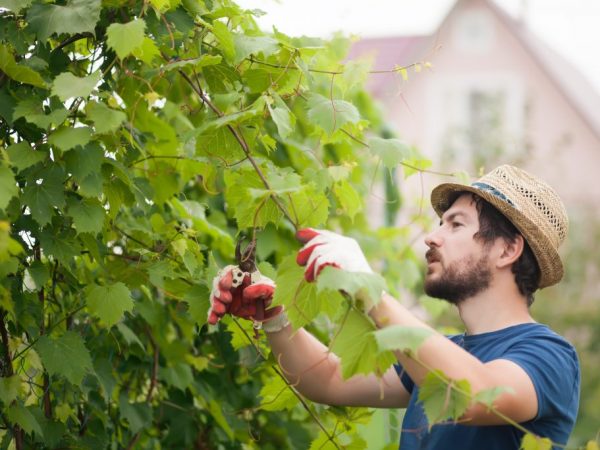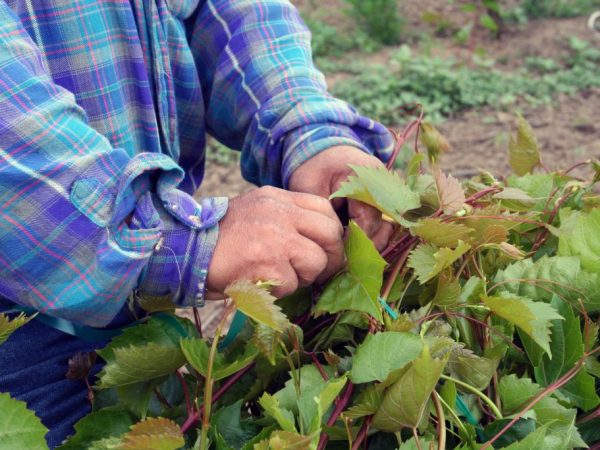Features of summer grape pruning
In the southern regions, the crop is cut only in spring and autumn. Fruits in such conditions get a lot of light and heat, the growing season is long. Pruning of grapes in summer is often carried out in the middle lane. It aims to remove shoots, leaves and ovaries.

Features of summer grape pruning
Summer pruning goals
Not all novice gardeners are aware of this stage of grape care. But if you do not perform the procedure, the plant significantly reduces the quantity and quality of the fruit.
Purposes of summer grape pruning:
- increased productivity;
- improving the taste and increasing the size of the berries;
- providing ventilation of the plant;
- acceleration of fruit ripening;
- disease prevention;
- an increase in the amount of nutrients;
- facilitating the care of the bush and harvesting.
After performing the manipulations, the plant reduces the waste of energy on the formation of young shoots and directs them to pouring berries. This adjustment helps to achieve a balance between fruitful and empty vines. The correct formation of the bush helps to improve the general condition of the culture.
Breaking off shoots
The underdeveloped and fragile shoots break off in late May - early June, depending on the climatic conditions of the region. Shoots by this time should reach 15-20 cm in length, then it will not be difficult to remove them. Inspect the vine for unnecessary branches once a week from June to August. This will allow for timely pruning, which will ensure an earlier harvest.
The branches that formed in the fall are tied to a support.
You should also remove wild growth that grows from the roots. The cultural one is not broken off, but used to form a bush. The stronger the plant, the more branches are left.
If the tops are not removed in time, they will take on some of the nutrition that is necessary for flowering and the formation of ovaries. And also new shoots will create shading. Fresh air and sunlight will not be able to penetrate the plant. Berries on thickened bushes do not pick up sugar, and the plant itself begins to ache.
Summer pruning benefits
If you cut off the grapes in the summer from unnecessary shoots, then you can achieve the following results:
- the load on the plant is evenly distributed;
- the harvest is laid (also for the next year);
- feed is directed to the brushes;
- access of the sun to the ovaries is provided.
Pinching
With the onset of spring, the reserves of nutrients in the vine begin to move towards the growth points. Apical shoots and inflorescences are no exception. When the lateral branches are actively developing, the hands may lack micronutrients. The plant sheds flowers, the inflorescences transform into tendrils.
To prevent this situation, grapes are pruned in the summer in the form of pinching the tops with unopened leaves. This gives the following results:
- the growth of lateral branches stops;
- inflorescences develop, forming ovaries;
- profuse flowering next year.

Pinching promotes ovary formation
The shoot is pinched in the middle of the internode above the first inflorescence. The event is combined with cutting out stepchildren or rationing of bunches. Pinching is also done when it is necessary to regulate the growth of the bush.
Stealing
Pruning grapes in July involves removing the lateral shoots that form between the main stem and the leaves.
The event should be carried out according to this principle: the stepson is not removed entirely, but a stump of 1.5 cm is left (a cut is made above the feather leaf). If you do not adhere to these recommendations, then a new one will quickly grow in the place of the broken branch. The antennae are also cut off. If the plant is tied to a support, all of them must be removed, since this organ is only intended for adhesion when branching.
It is worth making sure that 2 stepsons do not grow from one eye. If this happens, remove the smaller one. The procedure is performed for table varieties. The best time to prune grapes in this way is June. The procedure is repeated several times per season. Combine with a grape garter.
Chasing
The young shoots are shortened in August. This is done by hand or with a garden pruner or knife, which are pre-disinfected. The process resembles a pinching method. The difference is a deeper cutting of the apex. It begins when the lateral branch straightens and reaches 1-1.3 m. Then its apical part is removed with 5-8 opening leaves - 15-20% of the length of the stem.
If the chasing is done faster than the allotted time or if the shoots are cut too much, the vine will begin to intensively create stepchildren. Culture will spend a lot of energy on their education. Removing a lot of foliage will slow down the photosynthesis process. For the normal life of the culture, about 14 leaves should remain on the branches.
This type of grape pruning in summer is performed for vigorous bushes. It contributes to:
- preventing bud shedding;
- high productivity;
- increasing the taste of berries;
- prevention of disease development.
Some gardeners cut off some of the upper roots in August. This stimulates the lower root system.
Pruning after flowering
To increase the illumination and airing of the forming bunches, summer pruning of grapes is performed by removing part of the leaves (from 5 to 10 pieces). In addition to the one that creates shading, cut off the old foliage and the foliage below the bush. The procedure is performed when the fruits begin to ripen. It is recommended to produce it in regions where the summer period is short. In the South, indications for foliage removal are:
- wet and cool summer;
- growing vigorous varieties.
Pruning grapes in the summer after flowering also includes rationing the harvest. Remove some of the brushes.
To fully mature large clusters, small ones are removed. No more than 3 pieces are left on the shoots, if they are weak, then only one. Often a bunch is shortened with a sharp knife. Normalization is carried out when the berries have not yet begun to ripen. Thanks to such actions, much more nutrients will be supplied to the remaining fruits.
There is another option for obtaining an early and high-quality harvest - banding. For its implementation, the bark is cut off from a young branch in the form of a thin ring (1-3 mm). Then the culture directs nutrition to the bunches, as well as to those parts of the plant that are above the incision. The fruits, thanks to such actions, will ripen 2 weeks earlier. But the procedure is painful for the grapes, so it is not worth applying it every year.
Summer pruning features
The main events take place in autumn and spring. Before performing summer manipulations, novice gardeners should think over the shape of the bush, as well as the procedure. In regions with cold winters, a pruning scheme is used, in which a non-standard plant is formed. If the shelter is not provided - standard.
After completing all the manipulations, equal slices should remain.It is better if they are on the inside of the stem, then the wounds will heal faster. If the slices are from different sides, then the movement of the juice is hampered, which has a bad effect on the yield.
It is better to prune grapes in summer in the morning or in the evening. It is desirable that the weather is cloudy. For a young plant that bears fruit for only 1-2 years, branches with bunches are removed. Otherwise, the culture will not have enough strength to ripen them. The time for performing the procedure is adjusted according to the climatic conditions of the region.
Conclusion
Correct summer pruning of grapes is the key to a good harvest in the fall. It is produced from June to August.
You should not neglect the removal of unnecessary branches, otherwise the plant will start to hurt. And over time, it will turn into a wild-growing shrub.


